Multi-Attribute Analysis Using Coherency and Ant-Tracking Techniques for Fault and Fracture Detection in La Florida Anticline, Llanos Foothills, Colombia
Abstract
1. Introduction
2. Geological Setting
2.1. Stratigraphic Setting and Petroleum System
2.2. Structural Evolution of La Florida Anticline
2.3. Previous Fracture Analysis in Foothills and Cusiana
3. Research Methods
3.1. Post-Migration Data Conditioning and Image Enhancement
3.2. Coherence and Ant-Tracking Seismic Attribute Analysis
4. Results
4.1. 3D seismic Visualization of the La Florida Anticline
4.2. Comparison of Fracture Systems in Folded and Non-Folded Rocks near the Cusiana Fault
4.3. Secondary Fracture Orientations in Non-Folded Rocks of the Cusiana Footwall
4.4. Fracture Systems for the Guadalupe Group–Barco–Mirador Formation Reservoir Rocks
4.5. Regional Stress Field—Timing and Orientation of Footwall Block Fractures
4.5.1. Northeast–Southwest Trending Normal Faulting
4.5.2. Northwest–Southeast Trending Fracture Sets—Riedel shears?
5. Discussion
5.1. Comparison of Seismic Attribute Ant-Tracking Results with Previous Surface Mapping and Well Borehole Imager Log Results
5.2. Algeciras Fault System, Regional Shear Stresses, and NW–SE and WNW–ESE Fracture Sets
6. Conclusions
Author Contributions
Acknowledgments
Conflicts of Interest
References
- Cazier, E.C.; Hayward, A.B.; Espinosa, G.; Velandia, J.; Mugniot, J.F.; Leel, W.G., Jr. Petroleum geology of the Cusiana field, Llanos Basin foothills, Colombia. Aapg Bull. 1995, 79, 1444–1462. [Google Scholar]
- Cooper, M.A.; Addison, F.T.; Alvarez, R.; Coral, M.; Graham, R.H.; Hayward, A.B.; Howe, S.; Martinez, J.; Naar, J.; Peñas, R. Basin development and tectonic history of the Llanos Basin, Eastern Cordillera, and middle Magdalena Valley, Colombia. Aapg Bull. 1995, 79, 1421–1442. [Google Scholar]
- Tamara, J.; Mora, A.; Robles, W.; Kammer, A.; Ortiz, A.; Sanchez-Villar, N.; Piraquive, A.; Rueda, L.H.; Casallas, W.; Castellanos, J.; et al. Fractured reservoirs in the Eastern Foothills, Colombia, and their relationship with fold kinematics. Aapg Bull. 2015, 99, 1599–1633. [Google Scholar] [CrossRef]
- Engelder, T.; Lash, G.G.; Uzcátegui, R.S. Joint sets that enhance production from Middle and Upper Devonian gas shales of the Appalachian Basin. Aapg Bull. 2009, 93, 857–889. [Google Scholar] [CrossRef]
- Ortiz, A.; Mesa, G.D.; Beltran, R.X. Fracture modeling based on lithologic controls, geometry and tectonic evolution in the Llanos Foothills, Colombia. In Proceedings of the 2008 AAPG Annual Convention and Exhibition, San Antonio, TX, USA, 20–23 April 2008. [Google Scholar]
- Mora, A.; Parra, M.; Strecker, M.R.; Sobel, E.R.; Zeilinger, G.; Jaramillo, C.; Da Silva, S.F.; Blanco, M. The eastern foothills of the Eastern Cordillera of Colombia: An example of multiple factors controlling structural styles and active tectonics. Gsa Bull. 2010, 122, 1846–1864. [Google Scholar] [CrossRef]
- Albesher, Z.; Kellogg, J.; Hafiz, I.; Saeid, E. Structural Evolution of La Florida Anticline and Petroleum System in a Foreland Fold Belt, Eastern Cordillera Foothills, Colombia. In Proceedings of the 2019 AAPG Annual Convention and Exhibition, San Antonio, TX, USA, 19–22 May 2019. [Google Scholar]
- Parra, M.; Mora, A.; Jaramillo, C.; Strecker, M.R.; Sobel, E.R.; Quiroz, L.; Rueda, M.; Torres, V. Orogenic wedge advance in the northern Andes: Evidence from the Oligocene-Miocene sedimentary record of the Medina Basin, Eastern Cordillera, ColombiaOrogenic wedge advance in the northern Andes, Colombia. Gsa Bull. 2009, 121, 780–800. [Google Scholar] [CrossRef]
- Parra, M.; Mora, A.; Sobel, E.R.; Strecker, M.R.; González, R. Episodic orogenic front migration in the northern Andes: Constraints from low-temperature thermochronology in the Eastern Cordillera, Colombia. Tectonics 2009, 28. [Google Scholar] [CrossRef]
- Teixell, A.; Ruiz, J.-C.; Teson, E.; Mora, A. The structure of an inverted back-arc rift: Insights from a transect across the Eastern Cordillera of Colombia near Bogotá. Pet. Geol. Potential Colomb. Caribb. Margin: Aapg Spec. Vol. 2015, 108, 499–516. [Google Scholar] [CrossRef]
- Ramon, J.C.; Fajardo, A. Sedimentology, Sequence Stratigraphy, and Reservoir Architecture of the Eocene Mirador Formation, Cupiagua Field, Llanos Foothills, Colombia; The American Association of Petroleum Geologists: Tulsa, OK, USA, 2006; pp. 433–469. [Google Scholar] [CrossRef]
- Toro, J.; Roure, F.; Bordas-Le Floch, N.; Le Cornec-Lance, S.; Sassi, W. Thermal and Kinematic Evolution of the Eastern Cordillera Fold and Thrust Belt, Colombia; The American Association of Petroleum Geologists: Tulsa, OK, USA, 2004; pp. 79–115. [Google Scholar] [CrossRef]
- Reyes-Harker, A.; Ruiz-Valdivieso, C.F.; Mora, A.; Ramírez-Arias, J.C.; Rodriguez, G.; de la Parra, F.; Caballero, V.; Parra, M.; Moreno, N.; Horton, B.K.; et al. Cenozoic paleogeography of the Andean foreland and retroarc hinterland of ColombiaPaleogeography of the Northern Andes. Aapg Bull. 2015, 99, 1407–1453. [Google Scholar] [CrossRef]
- Sánchez, N.; Mora, A.; Parra, M.; Garcia, D.; Cortes, M.; Shanahan, T.M.; Ramirez, R.; Llamosa, O.; Guzman, M. Petroleum system modeling in the Eastern Cordillera of Colombia using geochemistry and timing of thrusting and deformationPetroleum Systems Modeling Colombia. Aapg Bull. 2015, 99, 1537–1556. [Google Scholar] [CrossRef]
- Parra, M.; Mora, A.; Jaramillo, C.; Torres, V.; Zeilinger, G.; Strecker, M.R. Tectonic controls on Cenozoic foreland basin development in the north-eastern Andes, Colombia. Basin Res. 2010, 22, 874–903. [Google Scholar] [CrossRef]
- Carrillo, E.; Mora, A.; Ketcham, R.A.; Amorocho, R.; Parra, M.; Costantino, D.; Robles, W.; Avellaneda, W.; Carvajal, J.S.; Corcione, M.F. Movement vectors and deformation mechanisms in kinematic restorations: A case study from the Colombian Eastern Cordillera. Interpretation 2016, 4, T31–T48. [Google Scholar] [CrossRef]
- Bande, A.; Horton, B.K.; Ramirez, J.C.; Mora, A.; Parra, M.; Stockli, D.F. Clastic deposition, provenance, and sequence of Andean thrusting in the frontal Eastern Cordillera and Llanos foreland basin of Colombia. Geol. Soc. Am. Bull. 2012, 124, 59–76. [Google Scholar] [CrossRef]
- Chopra, S. Interpreting fractures through 3-D seismic discontinuity attributes and their visualization. Cseg Rec. 2009, 34, 5–14. [Google Scholar]
- Matthäi, S.K.; Belayneh, M. Fluid flow partitioning between fractures and a permeable rock matrix. Geophys. Res. Lett. 2004, 31. [Google Scholar] [CrossRef]
- Chopra, S.; Marfurt, K.J. Seismic attributes for prospect identification and reservoir characterization. In Seismic Attributes for Prospect Identification and Reservoir Characterization; Hill, S.J., Ed.; Society of Exploration Geophysicists and European Association of Geoscientists and Engineers: Tulsa, OK, USA, 2007; pp. 1–464. [Google Scholar] [CrossRef]
- Liner, C.; Li, C.F.; Gersztenkorn, A.; Smythe, J. SPICE: A new general seismic attribute. In SEG Technical Program Expanded Abstracts 2004; Society of Exploration Geophysicists: Tulsa, OK, USA, 2004; pp. 433–436. [Google Scholar] [CrossRef]
- Marfurt, K.J. Seismic Attributes as the Framework for Data Integration Throughout the Oilfield Life Cycle. In Seismic Attributes as the Framework for Data Integration Throughout the Oilfield Life Cycle; Society of Exploration Geophysicists: Tulsa, OK, USA, 2018; pp. 459–477. [Google Scholar] [CrossRef]
- Singh, S.K.; Abu-Habbiel, H.; Khan, B.; Akbar, M.; Etchecopar, A.; Montaron, B. Mapping fracture corridors in naturally fractured reservoirs: An example from Middle East carbonates. First Break 2008, 26. [Google Scholar]
- Randen, T.; Sønneland, L.; Carrillat, A.; Valen, T.S.; Skov, T.; Pedersen, S.I.; Rafaelsen, B.; Elvebakk, G. Preconditioning for optimal 3D stratigraphical and structural inversion. In Proceedings of the EAGE 65th Conference & Exhibition, Stavanger, Norway, 2–5 June 2003. [Google Scholar]
- Pedersen, S.I.; Randen, T.; Sonneland, L.; Steen, Y. Automatic fault extraction using artificial ants. In SEG Technical Program Expanded Abstracts 2002; Society of Exploration Geophysicists: Tulsa, OK, USA, 2002; pp. 512–515. [Google Scholar] [CrossRef]
- Wells, N.A. Are There Better Alternatives to Standard Rose Diagrams? J. Sediment. Res. 2000, 70, 37–46. [Google Scholar] [CrossRef]
- Stearns, D.W. Certain Aspects of Fractures in Naturally DEFORMED Rocks, in Rock Mechanics Seminar: Bedford; Riecker, R.E., Ed.; Terrestrial Sciences Laboratory: Greenbelt, MD, USA, 1968; pp. 97–118. [Google Scholar]
- Riedel, W. Zur Mechanik Geologischer Brucherscheinungen: Zentral-blatt fur Mineralogie. Geol. Und Paleontol. 1929, 354–368. [Google Scholar]
- Egbue, O.; Kellogg, J.; Aguirre, H.; Torres, C. Evolution of the stress and strain fields in the Eastern Cordillera, Colombia. J. Struct. Geol. 2014, 58, 8–21. [Google Scholar] [CrossRef]
- Egbue, O.; Kellogg, J. Pleistocene to Present North Andean “escape”. Tectonophysics 2010, 489, 248–257. [Google Scholar] [CrossRef]
- Saeid, E.; Bakioglu, K.B.; Kellogg, J.; Leier, A.; Martinez, J.A.; Guerrero, E. Garzón Massif basement tectonics: Structural control on evolution of petroleum systems in upper Magdalena and Putumayo basins, Colombia. Mar. Pet. Geol. 2017, 88, 381–401. [Google Scholar] [CrossRef]
- Anderson, V.J.; Horton, B.K.; Saylor, J.E.; Mora, A.; Tesón, E.; Breecker, D.O.; Ketcham, R.A. Andean topographic growth and basement uplift in southern Colombia: Implications for the evolution of the Magdalena, Orinoco, and Amazon river systems. Geosphere 2016, 12, 1235–1256. [Google Scholar] [CrossRef]
- Chorowicz, J.; Chotin, P.; Guillande, R. The Garzon fault: Active southwestern boundary of the Caribbean plate in Colombia. Geol. Rundsch. 1996, 85, 172–179. [Google Scholar] [CrossRef]
- Velandia, F.; Acosta, J.; Terraza, R.; Villegas, H. The current tectonic motion of the Northern Andes along the Algeciras Fault System in SW Colombia. Tectonophysics 2005, 399, 313–329. [Google Scholar] [CrossRef]
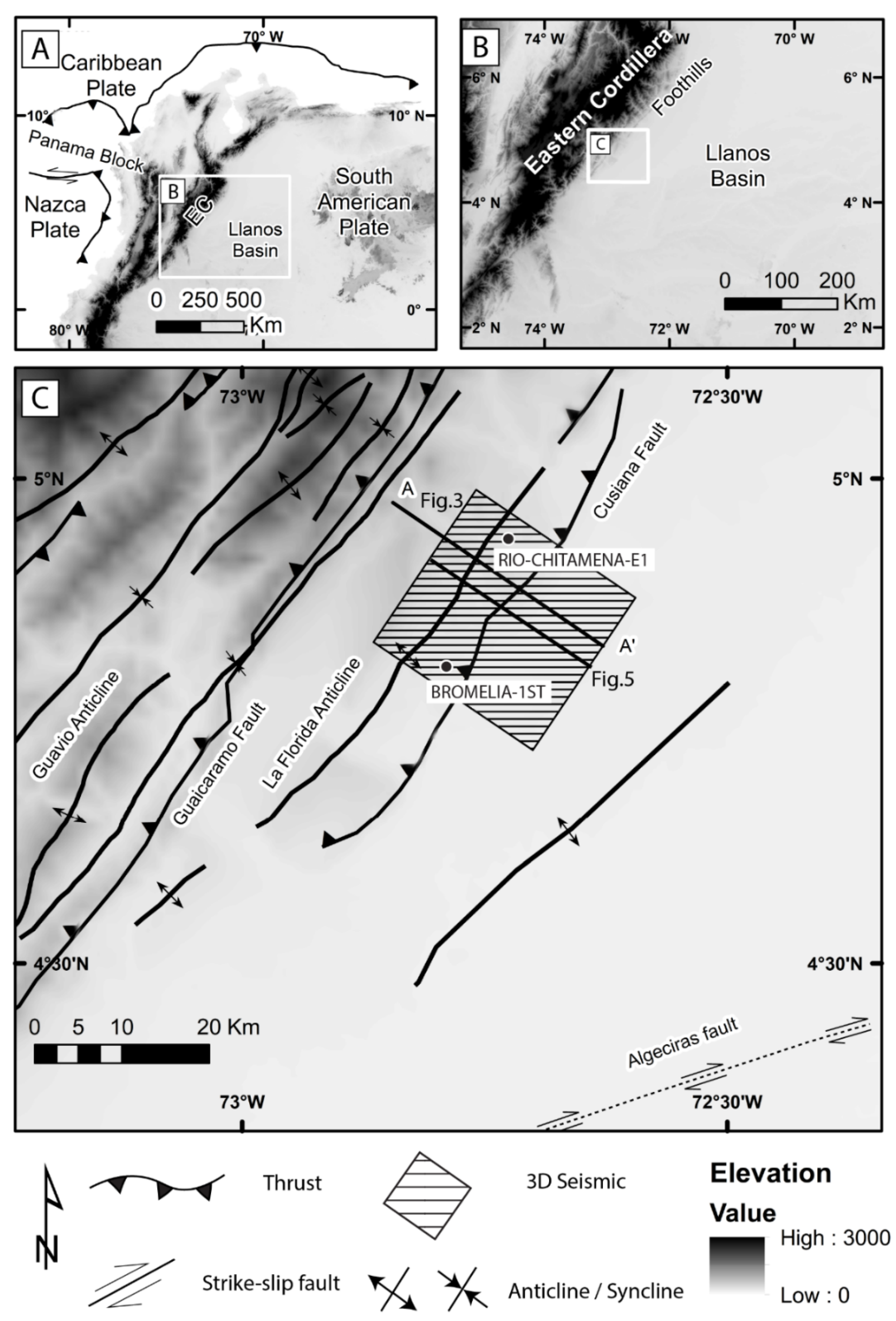
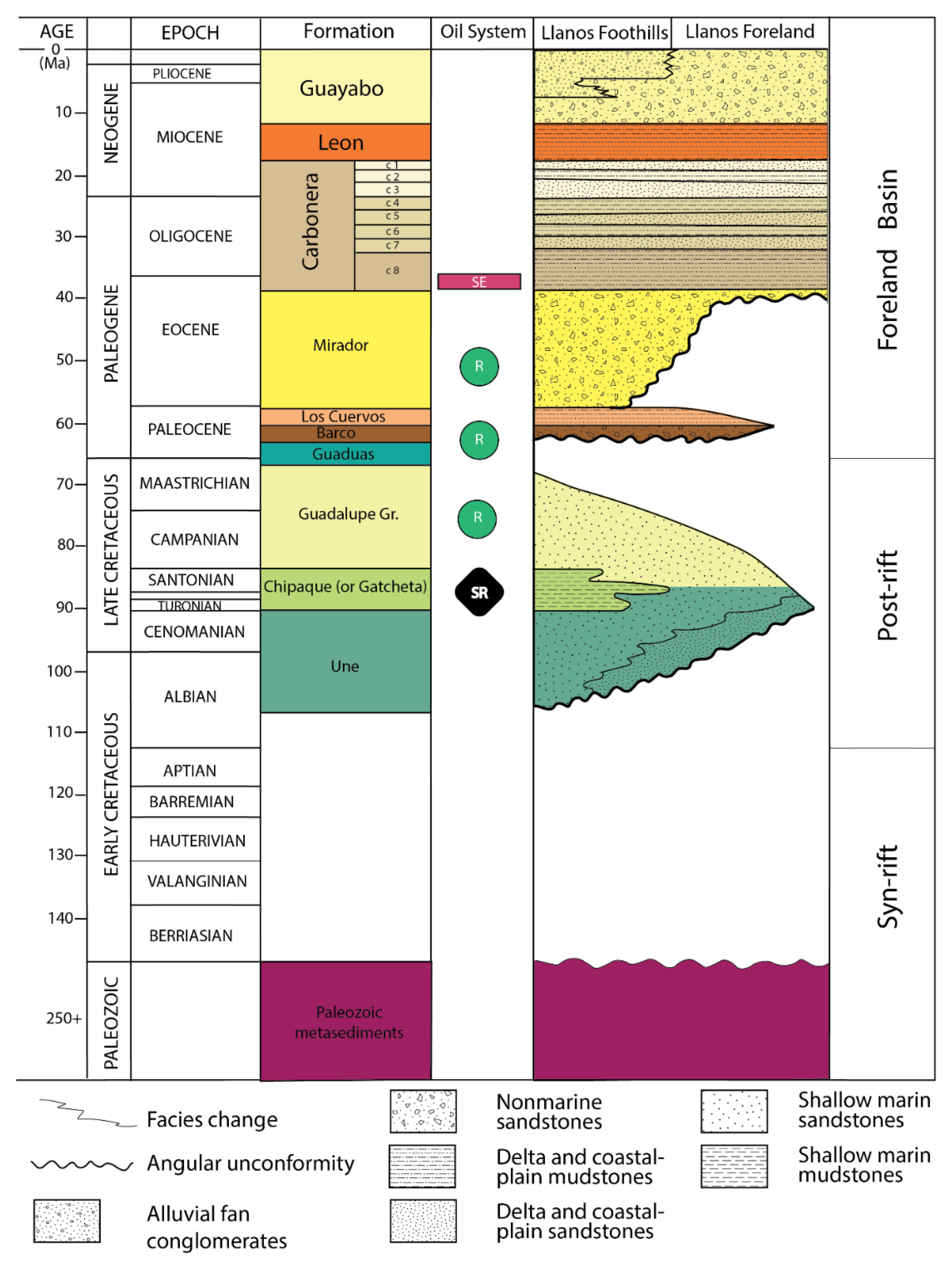
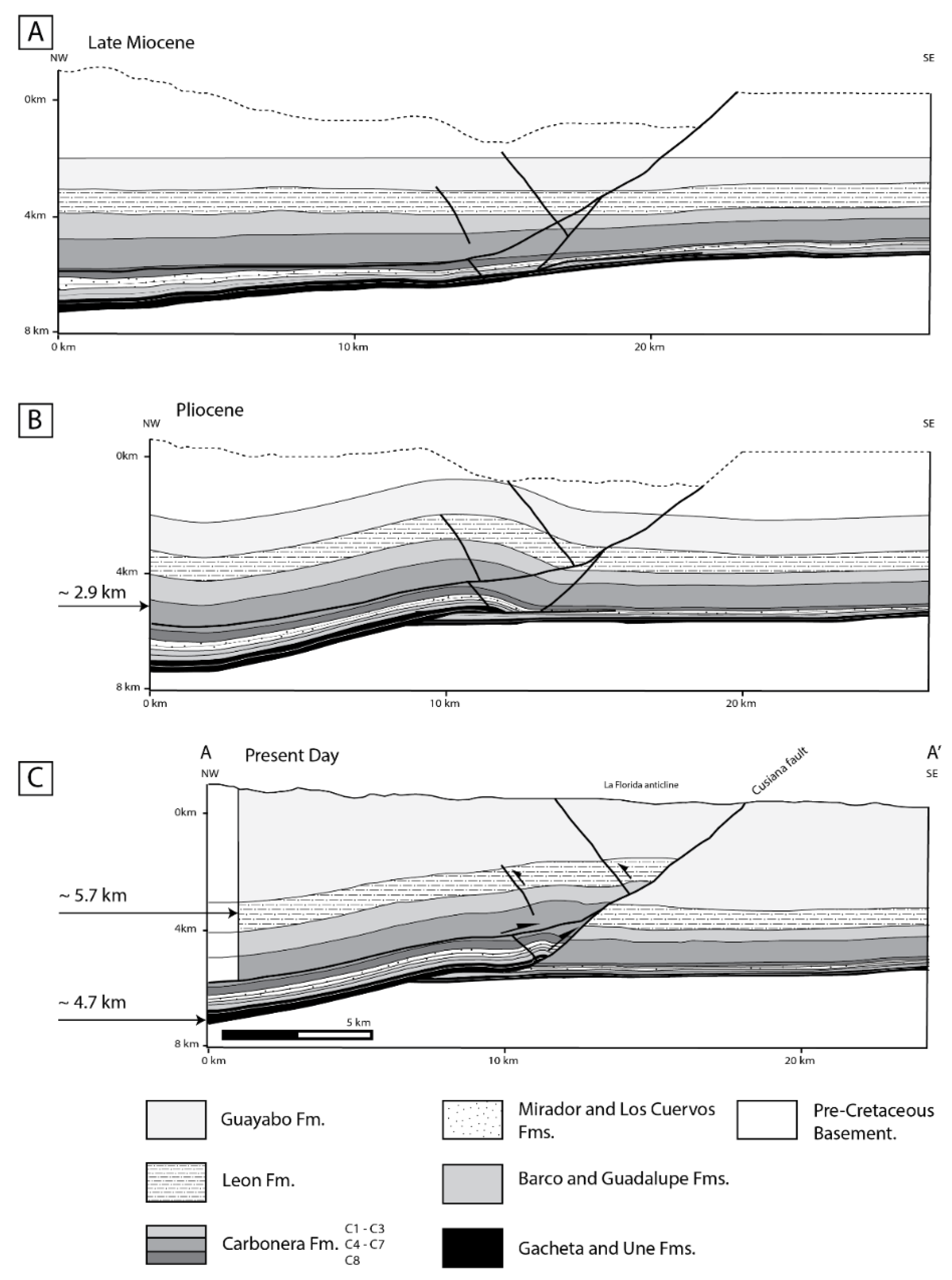

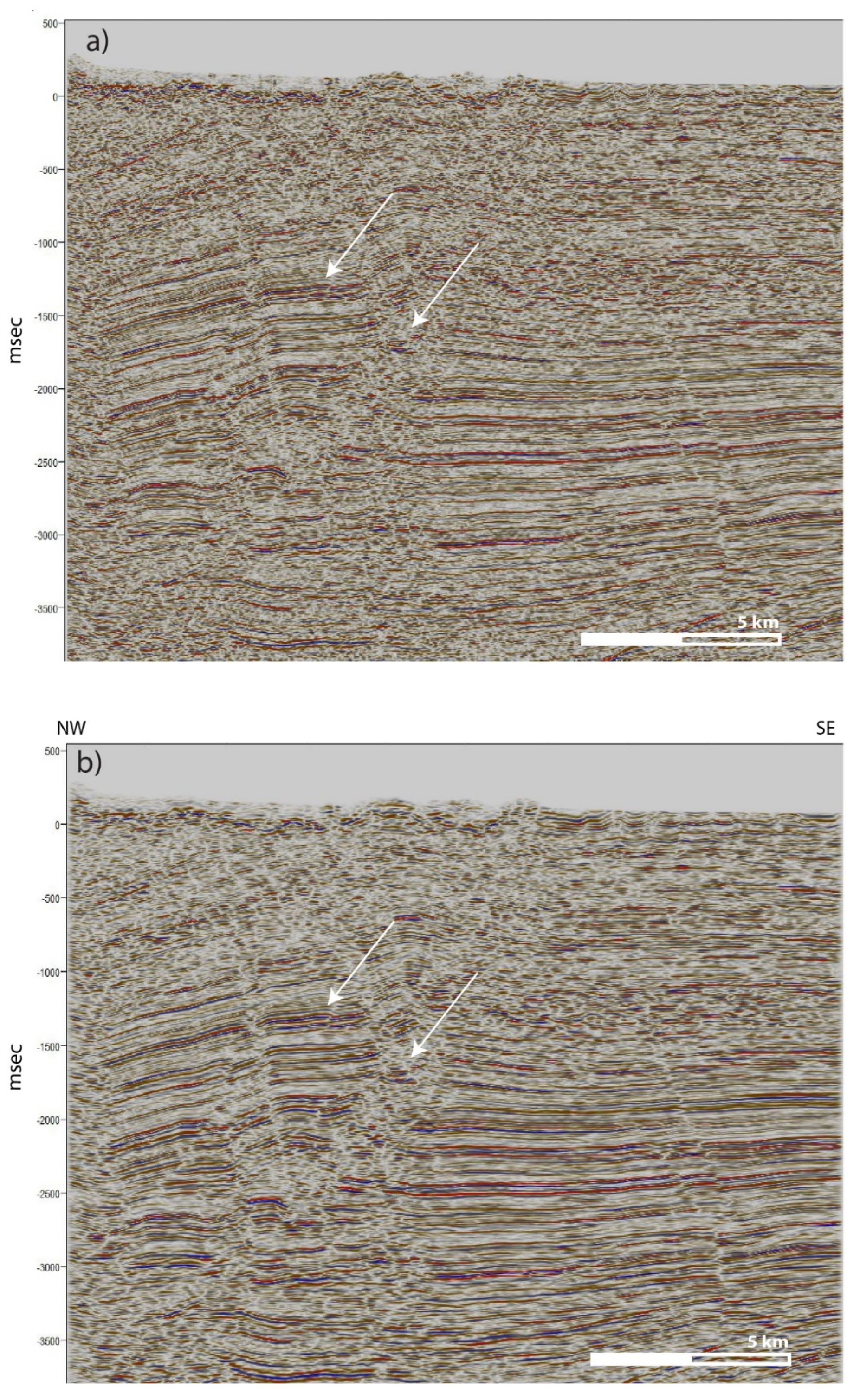
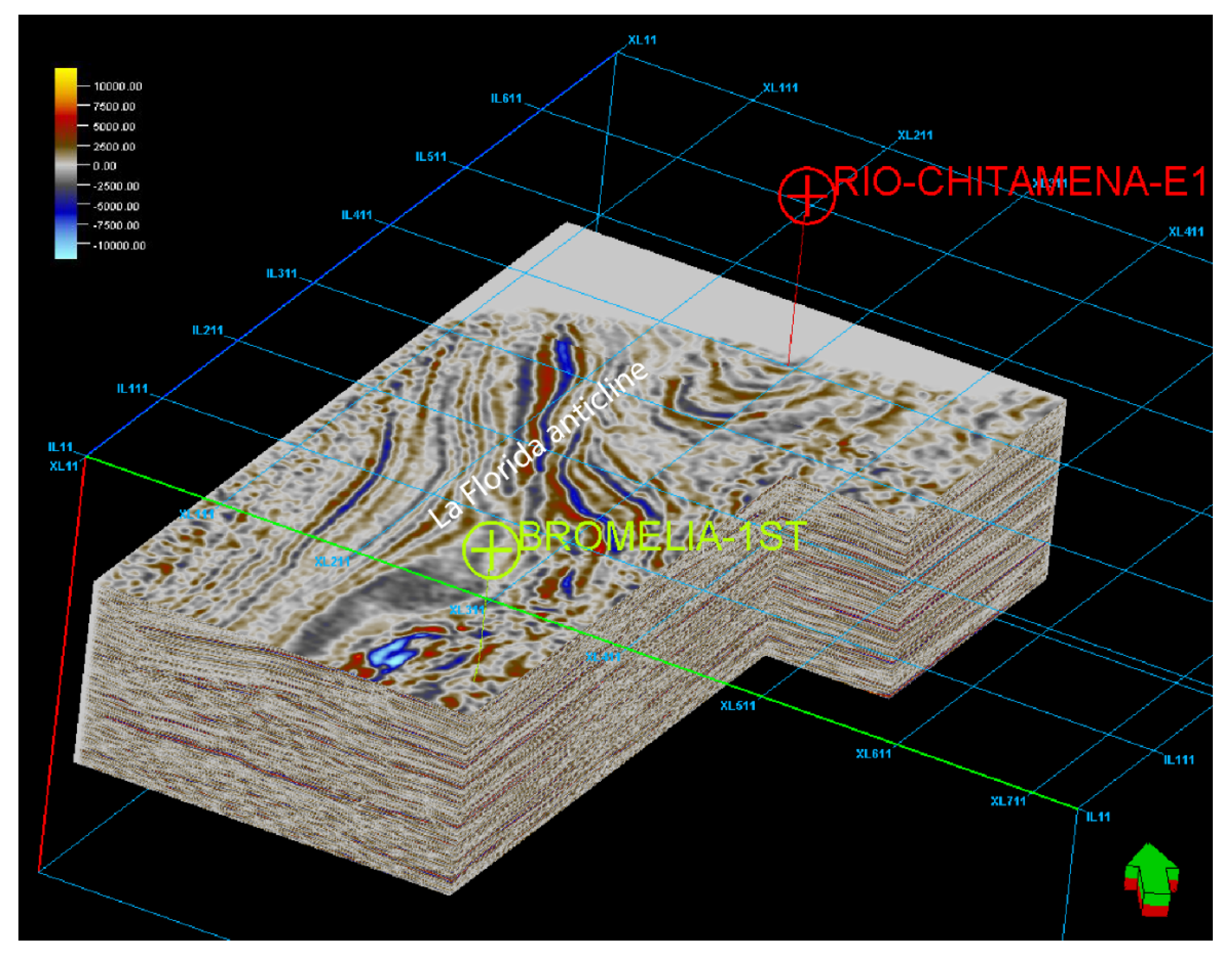
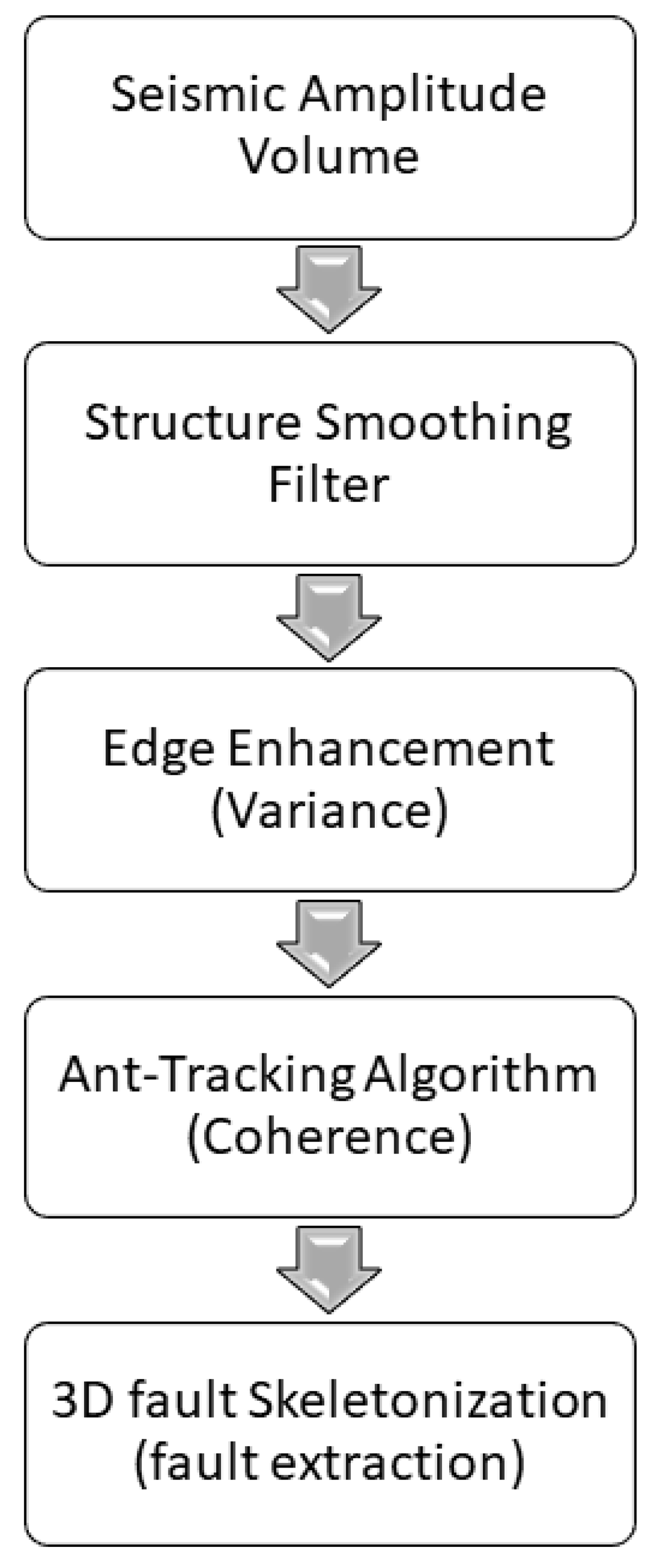
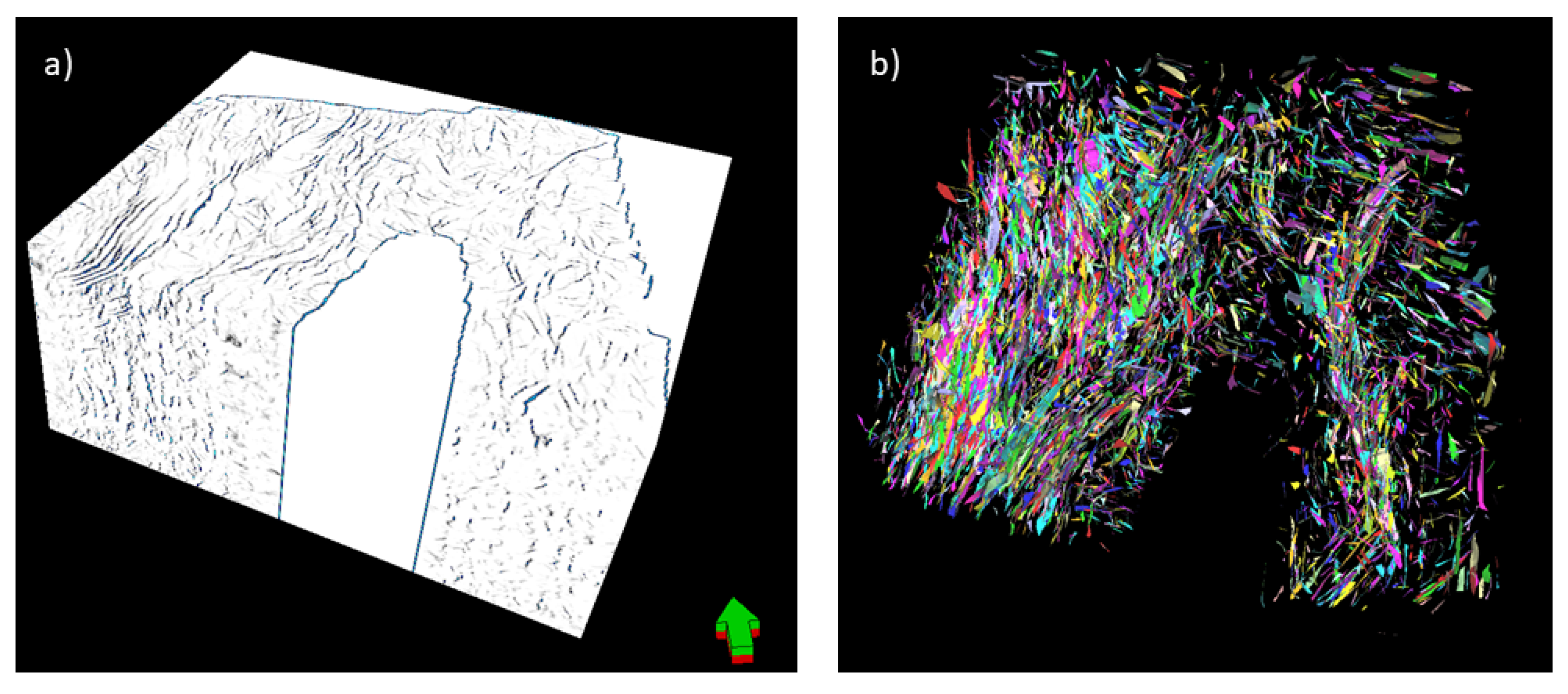
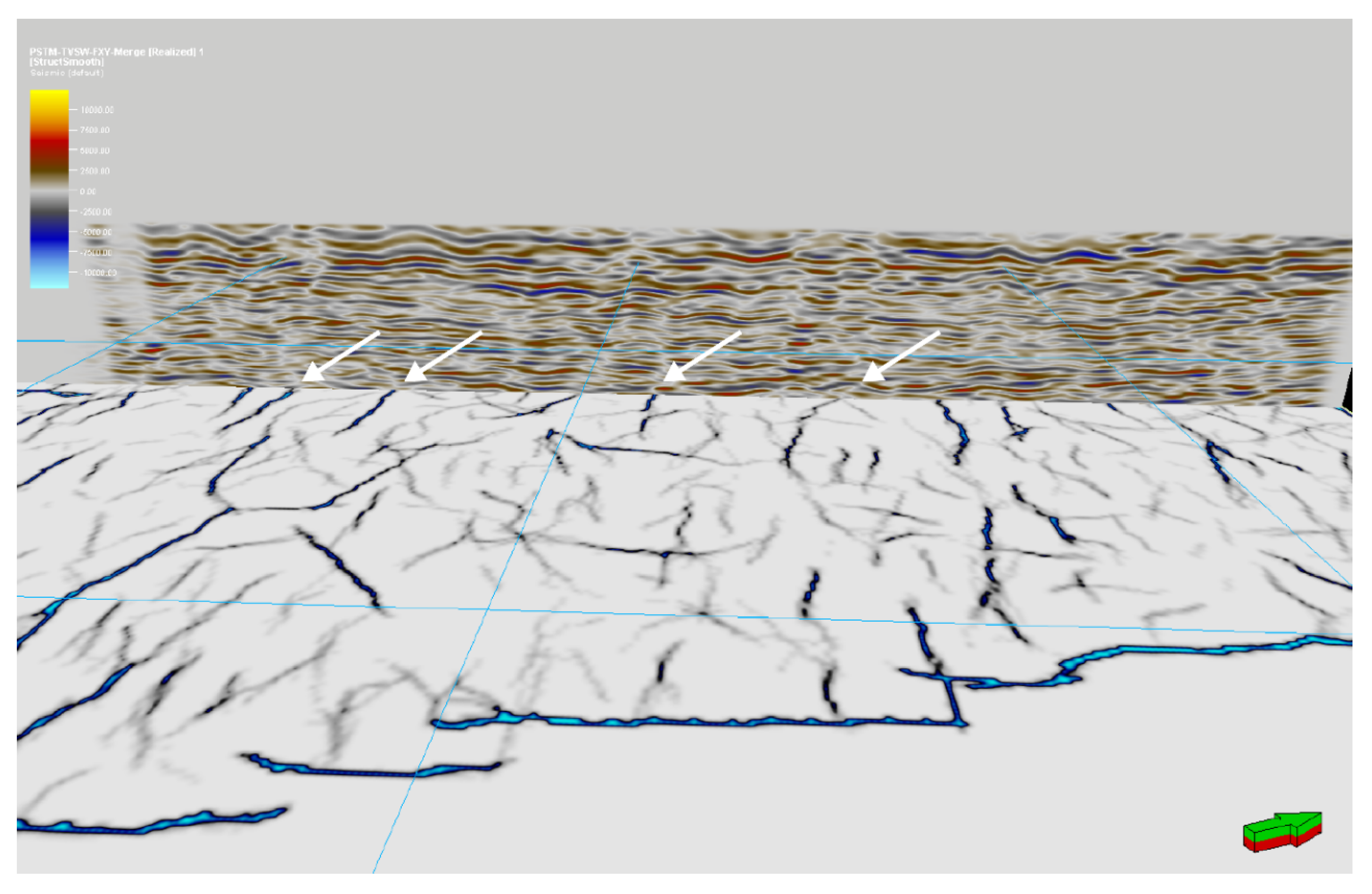
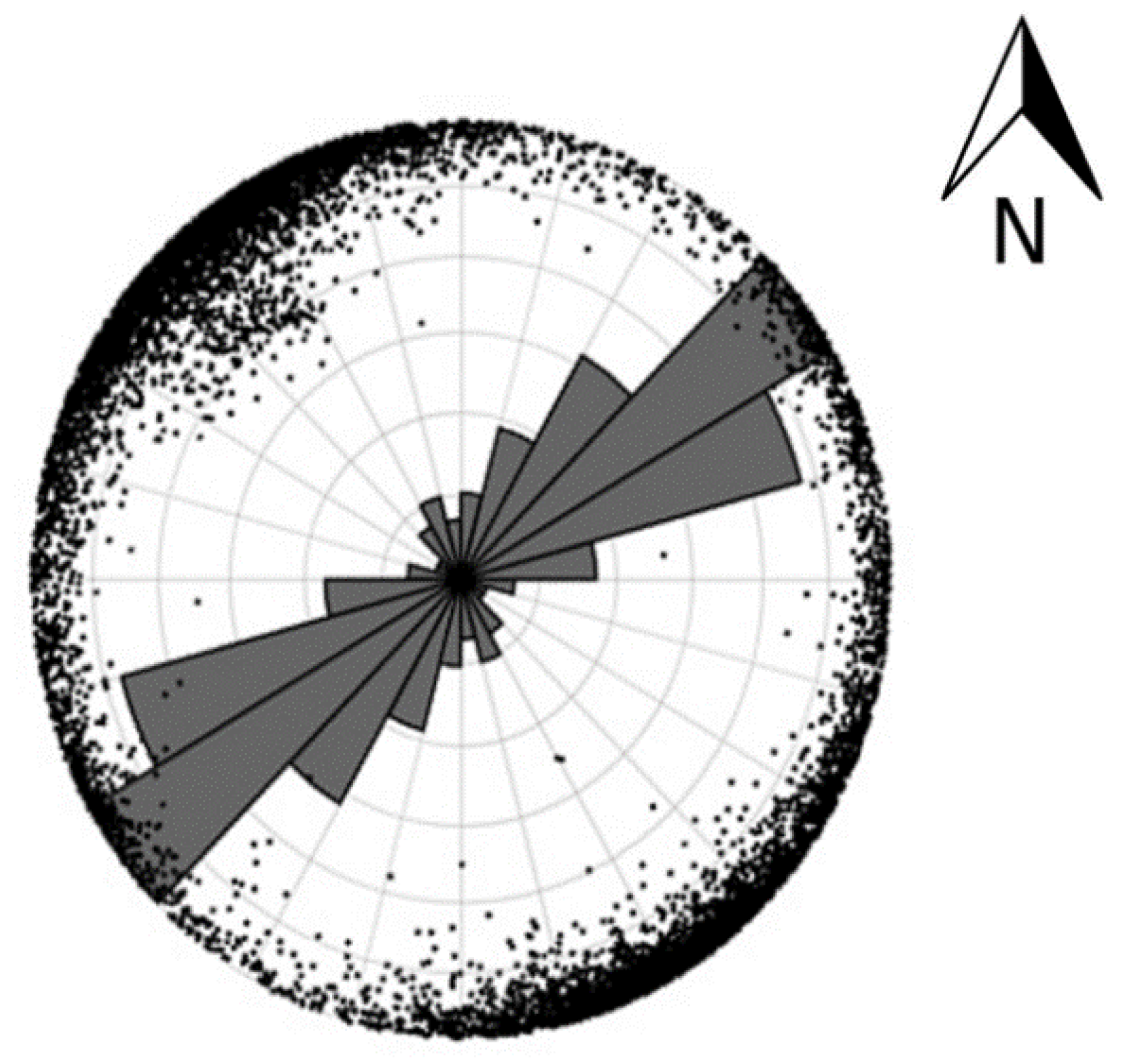
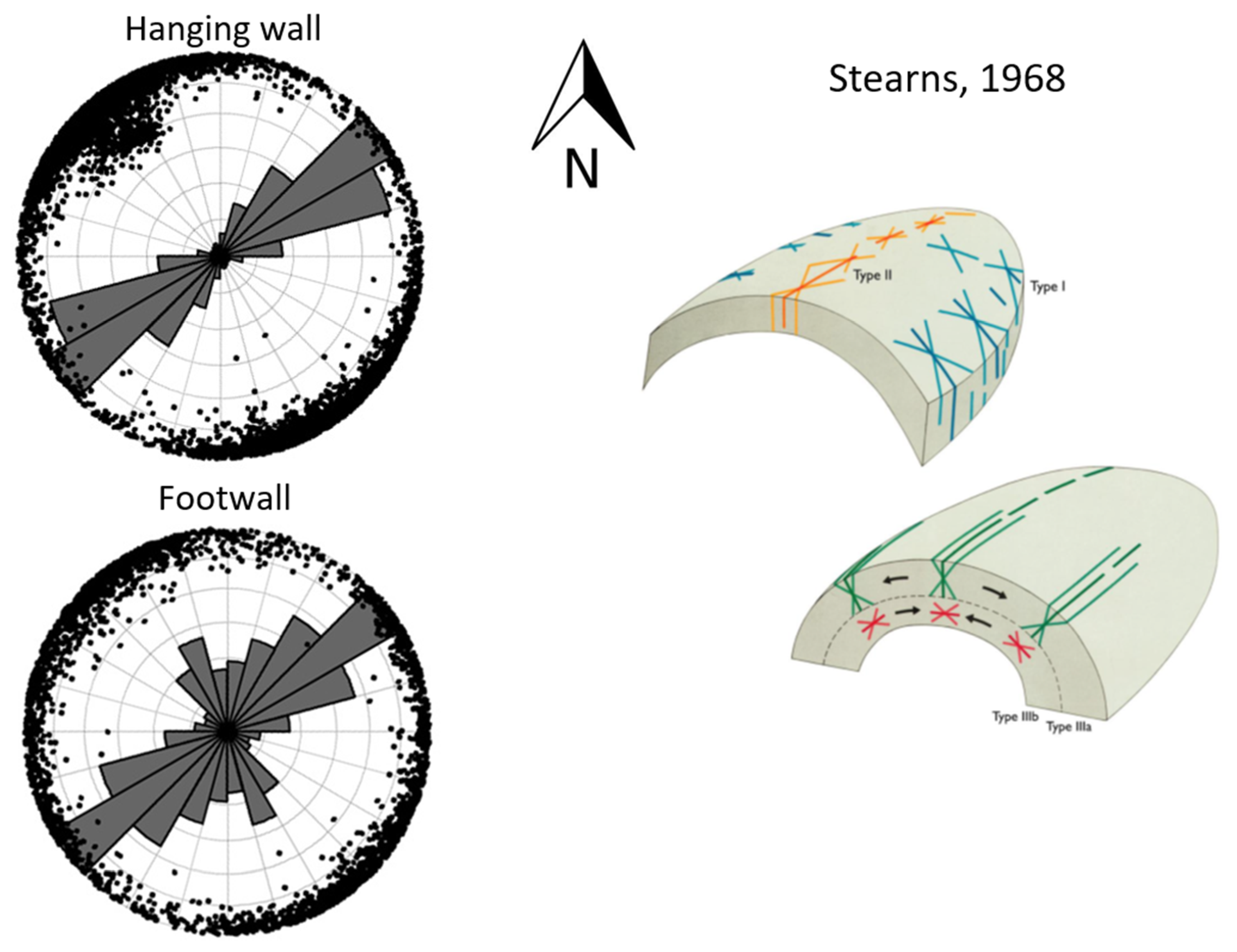
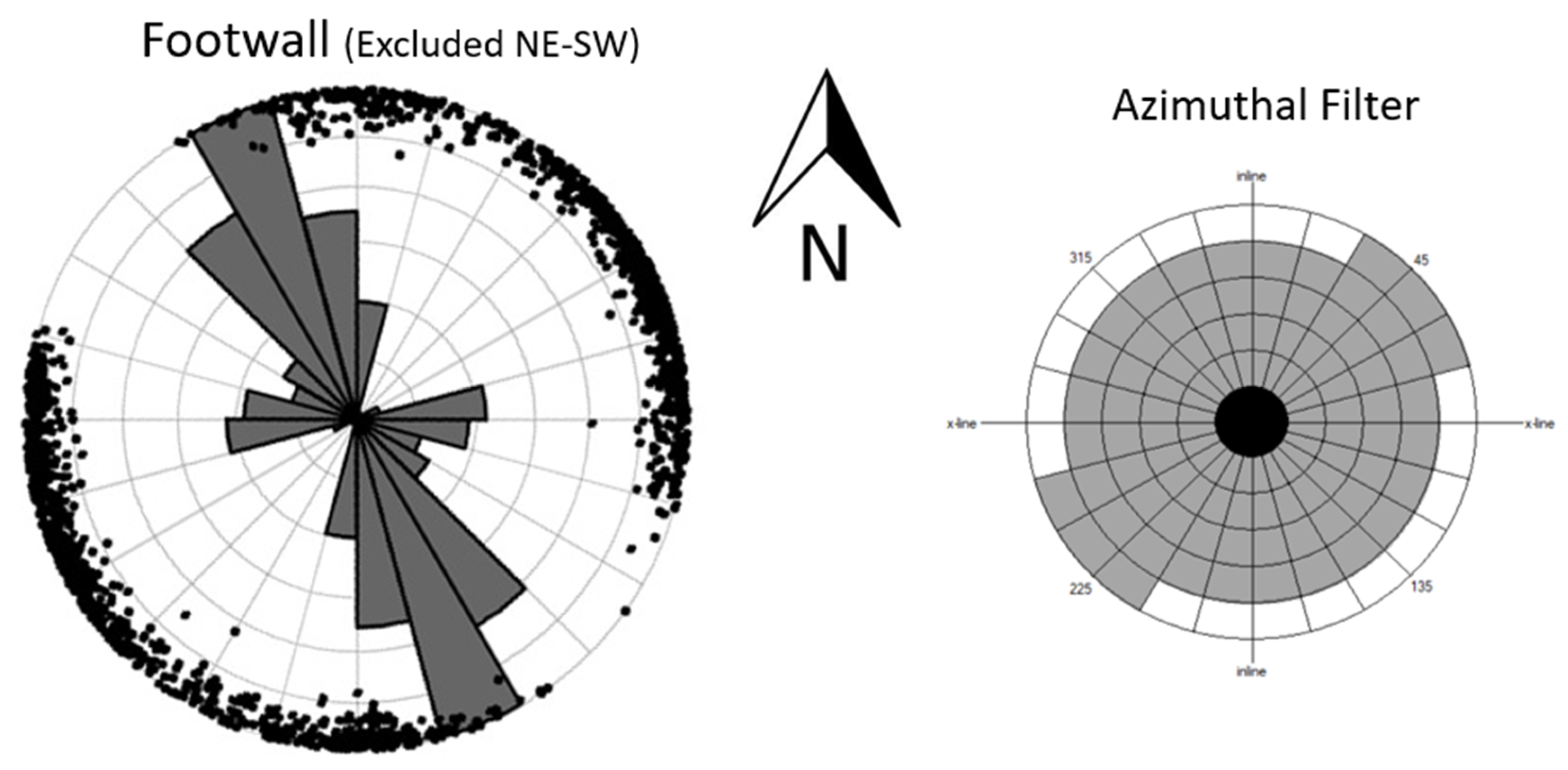
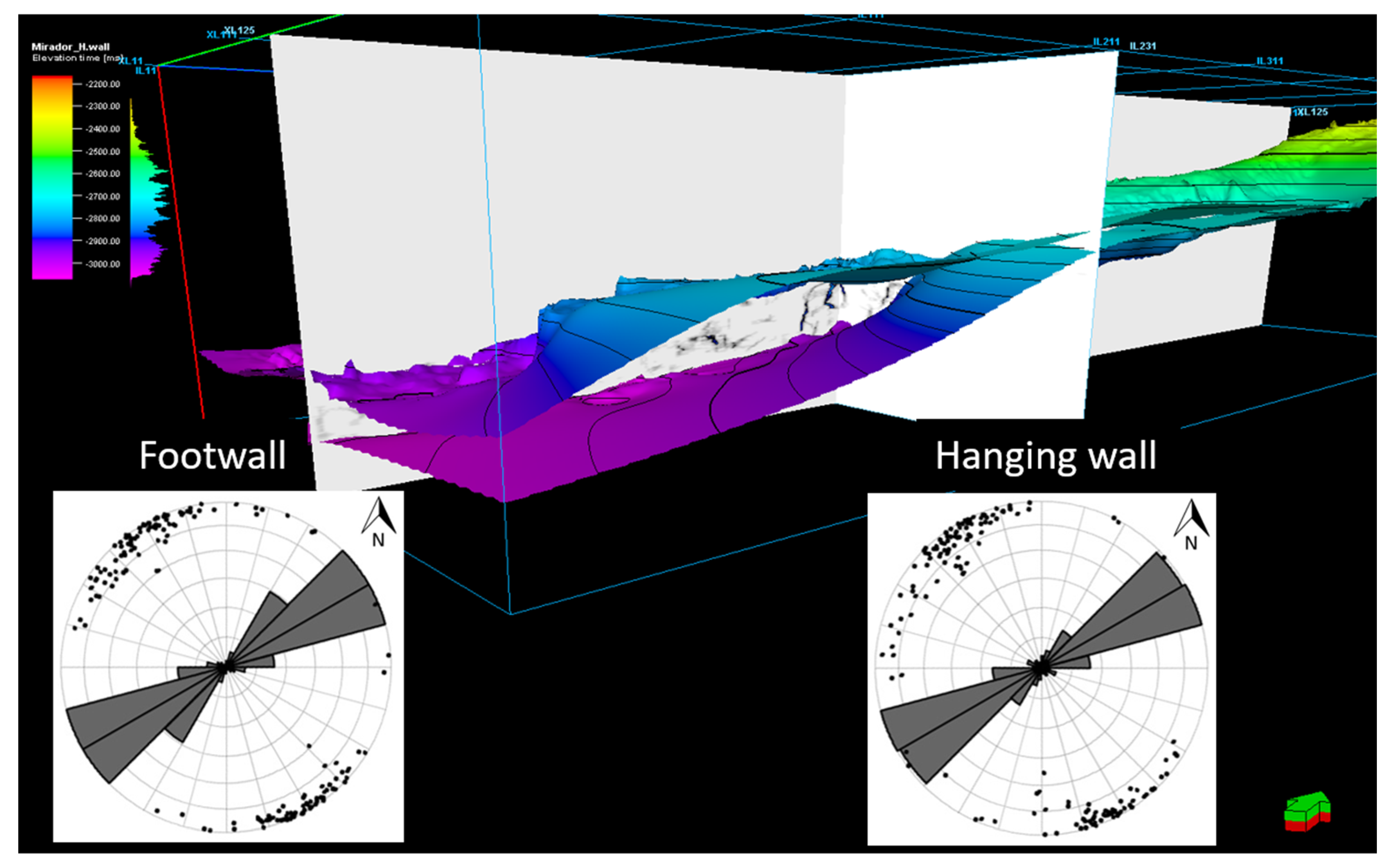
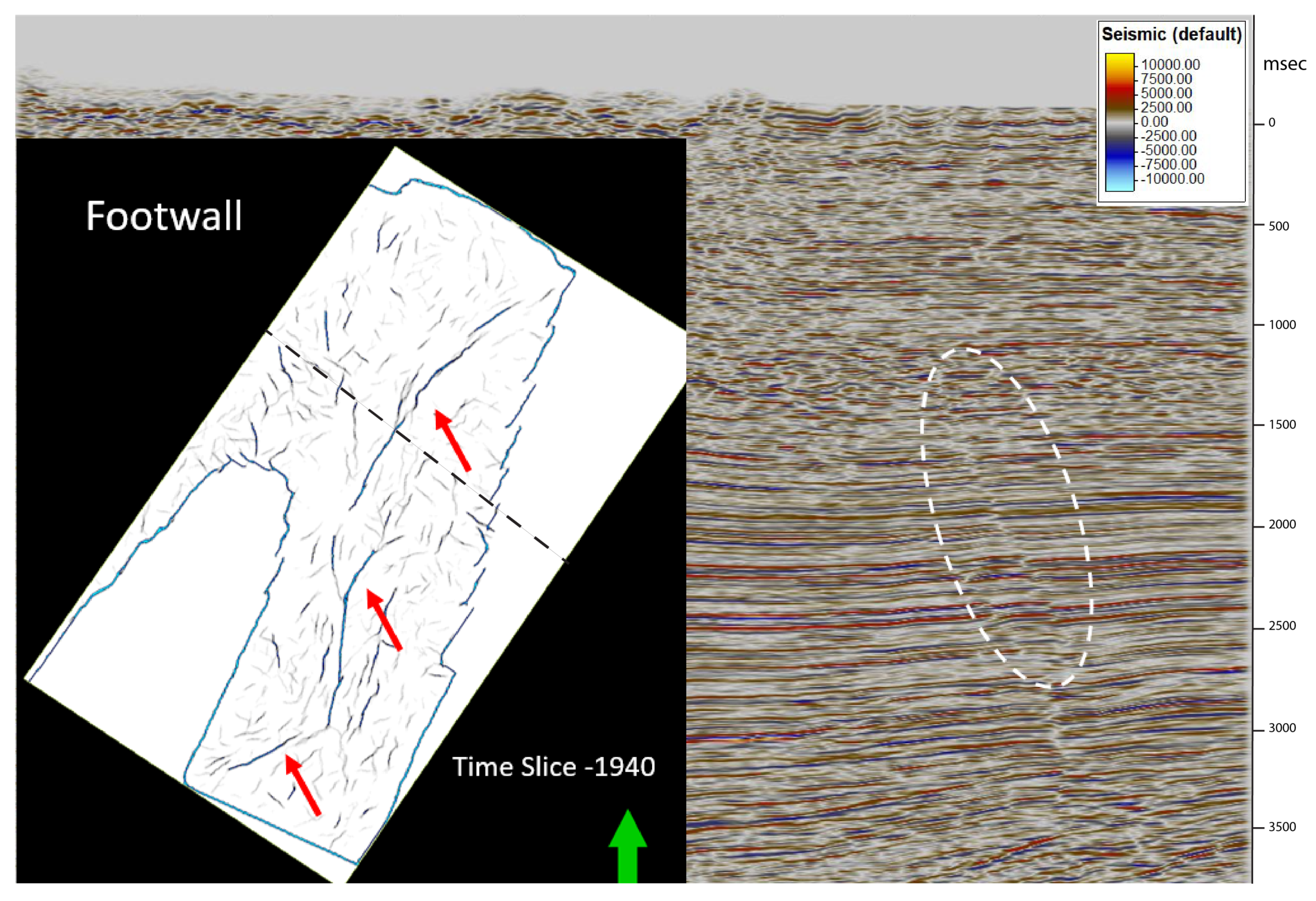
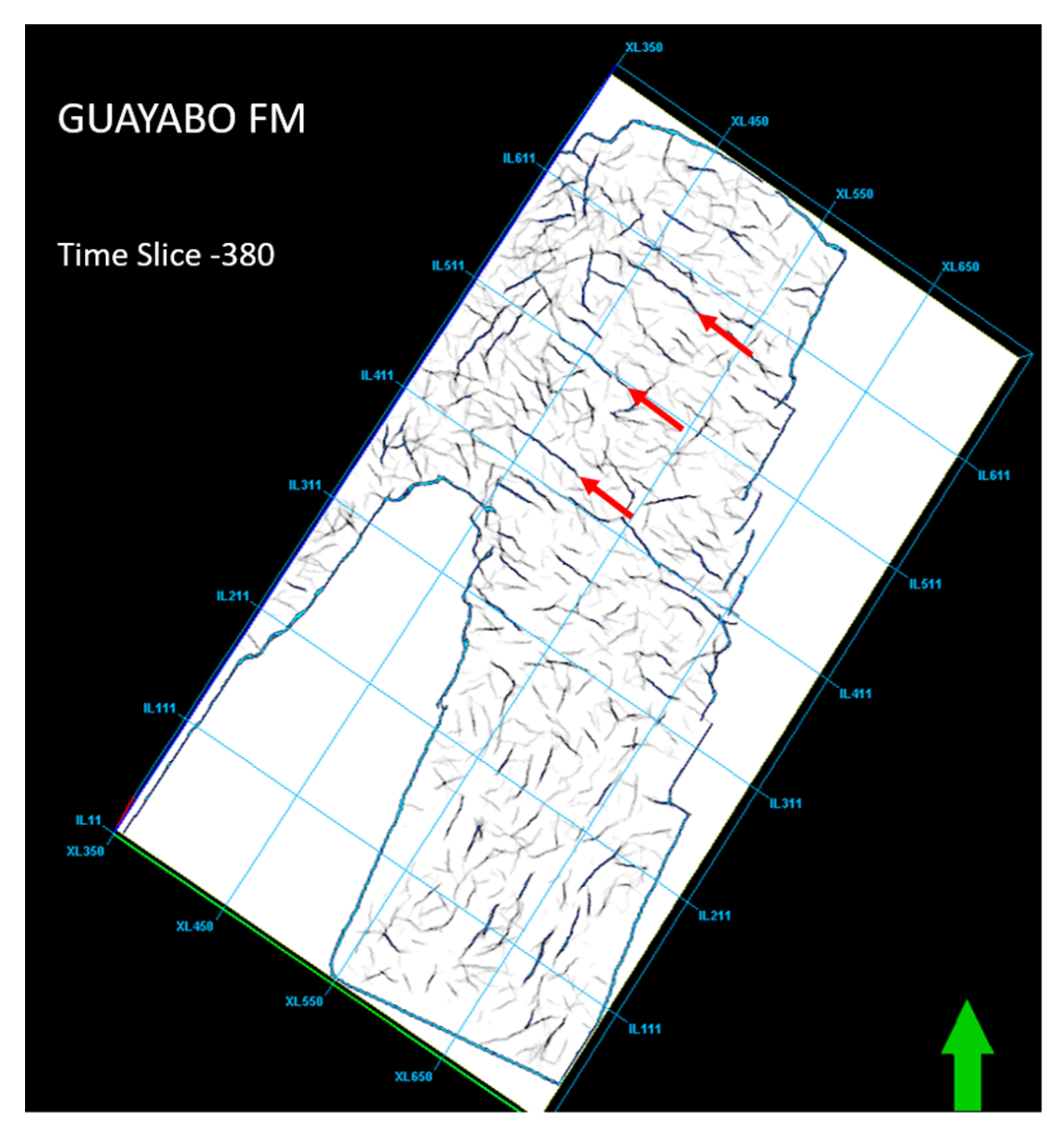

© 2020 by the authors. Licensee MDPI, Basel, Switzerland. This article is an open access article distributed under the terms and conditions of the Creative Commons Attribution (CC BY) license (http://creativecommons.org/licenses/by/4.0/).
Share and Cite
Albesher, Z.; Kellogg, J.; Hafiza, I.; Saeid, E. Multi-Attribute Analysis Using Coherency and Ant-Tracking Techniques for Fault and Fracture Detection in La Florida Anticline, Llanos Foothills, Colombia. Geosciences 2020, 10, 154. https://doi.org/10.3390/geosciences10040154
Albesher Z, Kellogg J, Hafiza I, Saeid E. Multi-Attribute Analysis Using Coherency and Ant-Tracking Techniques for Fault and Fracture Detection in La Florida Anticline, Llanos Foothills, Colombia. Geosciences. 2020; 10(4):154. https://doi.org/10.3390/geosciences10040154
Chicago/Turabian StyleAlbesher, Ziyad, James Kellogg, Ibraheem Hafiza, and Essam Saeid. 2020. "Multi-Attribute Analysis Using Coherency and Ant-Tracking Techniques for Fault and Fracture Detection in La Florida Anticline, Llanos Foothills, Colombia" Geosciences 10, no. 4: 154. https://doi.org/10.3390/geosciences10040154
APA StyleAlbesher, Z., Kellogg, J., Hafiza, I., & Saeid, E. (2020). Multi-Attribute Analysis Using Coherency and Ant-Tracking Techniques for Fault and Fracture Detection in La Florida Anticline, Llanos Foothills, Colombia. Geosciences, 10(4), 154. https://doi.org/10.3390/geosciences10040154



